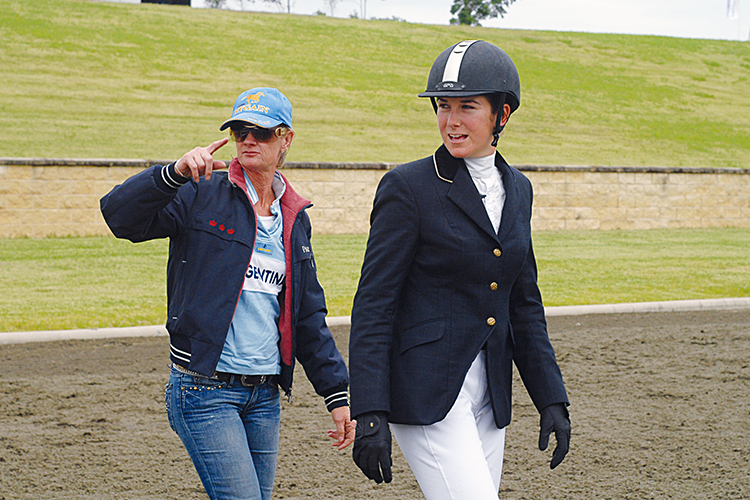 Over the past few months, you’ve sat in on a series of training sessions as Victorian showjumping coach, Michelle Strapp, has worked with the exciting young jumping talent, Amy Graham and her horses – most notably her World Cup ride, Transatlantic alias Charlie.
Over the past few months, you’ve sat in on a series of training sessions as Victorian showjumping coach, Michelle Strapp, has worked with the exciting young jumping talent, Amy Graham and her horses – most notably her World Cup ride, Transatlantic alias Charlie.
This month, we join Amy and Michelle at the recent ISS Australian Showjumping Championships at SIEC, to see how all the theory pans out in reality… but as always with Michelle – indeed with any good coach – there is a bit more theory first. I asked Michelle to analyse the course for the Mini Prix:
“The course didn’t have any major problems for Amy – except one area. Charlie doesn’t have a naturally big stride, and watching the last few shows in the run up to the Australian Champs on the DVD, I saw that while Amy has won a few classes and gone very well, she’s been getting into trouble occasionally by trying to get Charlie to go forward by throwing her hand at him – and he’s been getting long and catching a few fences a little open. He’s having to bust himself to do that, and so getting weak. It wasn’t in our plan to start in the Mini Prix. Our aim was the Australian Championship at SIEC, we weren’t necessarily going to start in the Mini Prix, we thought we’d keep him fresh for the speed class later in the day that was the first leg of the Championship.”
“But we felt that we needed the Mini prix start, he was just a bit scratchy. Then in the first round of the Mini Prix, the only line that was difficult for Amy, was the Liverpool, which was a positive five up to the oxer. Even in the practice ring, she didn’t have Charlie in front of her leg, she was still trying to chase him to create the energy. As she cantered up to her first fence, Amy immediately felt that it was a negative distance because he wasn’t in front of her leg. We had planned to do the just first round as a warm up for the Australian Championship, but because she didn’t quite get the ride she wanted, then we decided to put him in the second round.”
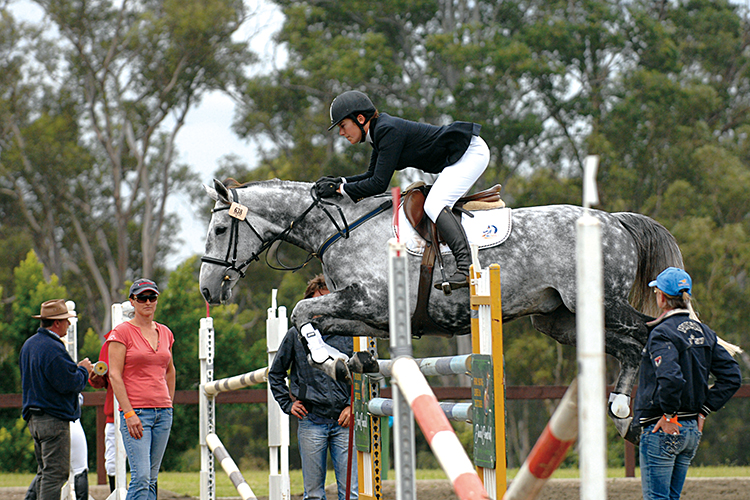
“In the practice ring before the second round, I got her to walk, then use her spur to get him active, and then come to the practice fence within six strides – to understand that she doesn’t need to wind him up to get the activity, that she actually just has to get him in front of her leg. So it was a totally different picture in the practice area and in the second round.”
“She came out of the ring after the second round with a smile on her face because she felt what she was trying to achieve. She gets frustrated when she is not perfect but then doesn’t understand how to fix it.”
“We would have liked to keep him fresher for the first round in the afternoon, but it was ideal for the jockey – if she’d gone into the big class with him a bit weak like that, she would have been in trouble. Yes, we might have him a little tired, but at least she was going to get a better feeling when she cantered him into that big class. We knew she would have him seriously in front of her leg for those bigger lines.”
And yes, Amy and Transatlantic won the Mini Prix class…
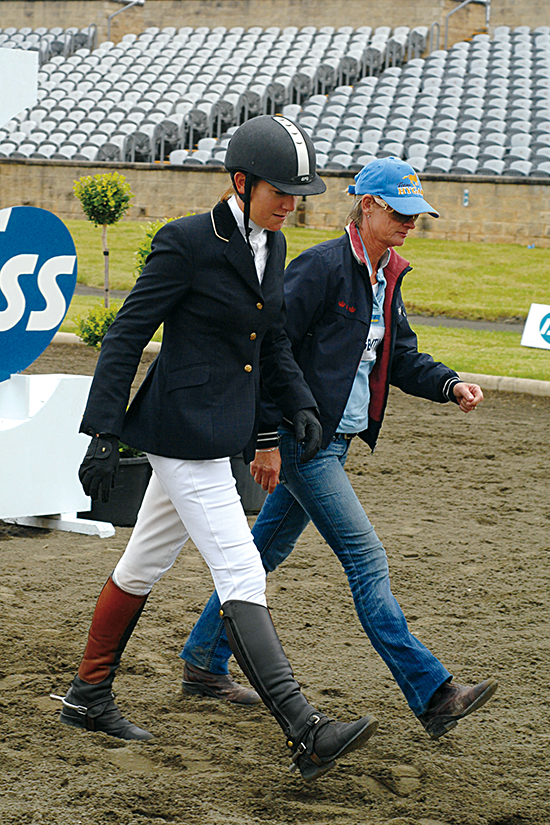
Amy appreciated the big Olympic arena:
“Good track, a more open track than we’ve been jumping over the past four weeks. We’ve been in little arenas, the Veladrome at Mt Gambier, Copabella is not huge, and especially J K Williams. So I had to focus on getting him up, in front of my leg, and getting him into a 350-400 canter. I struggled the first round, but it was much better in the second round. In the second round I got him sharper off my leg. I have to learn the difference between chasing him across the ground to really getting the activity behind, really getting him into my hand. I’ve got to learn how much ‘steel’ I’ve got in my hand, then I can wait, I have more horse coming through from behind. Then my distances come up a lot better, I’m not getting long flat distances.”
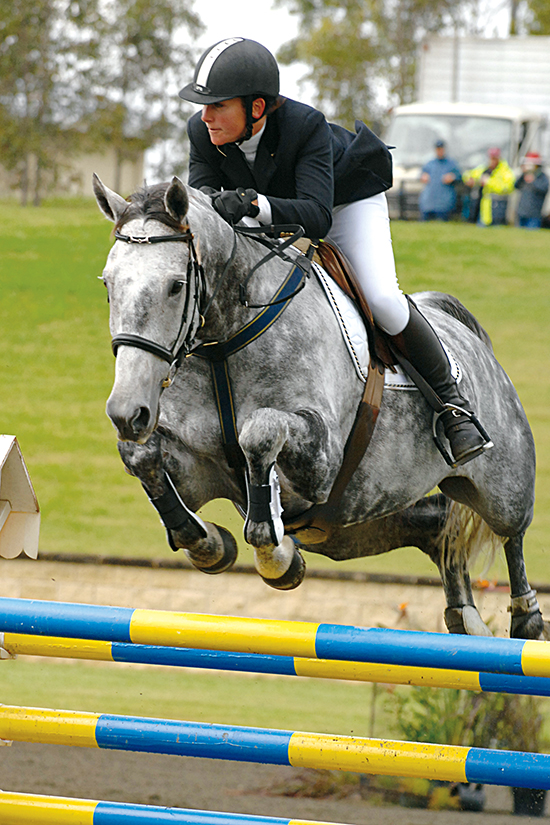
You’ve been having success recently, does that give you an extra edge?
“I think one of the things that gives you the biggest edge is confidence. You have good shows and you build your confidence. Look particularly at some of the male riders, they can have a bit of an ego, but they have so much confidence in themselves, that definitely gives them an edge.”
“In the jumpoff, I was more focusing on my canter than the actual round. It was a warmup class for me. He would be a very good Mini Prix horse, but I want him for my Grand Prix. I wanted him to come out in the afternoon, in front of my leg.”
So while the worry was the horse might be tired it was still a very positive run in to the speed class in the afternoon, the first Australian Championship Course.
THE CHAMPIONSHIP
Michelle analyses Amy’s round which resulted in two rails down, and just missing the jump off:
“One to two was a six stride distance, it actually walks like a five and a half stride distance. Amy did a great job down that line because Charlie actually turned the corner and started to have a look, but she had him far enough in front of her leg and that the six rode really well for her.”
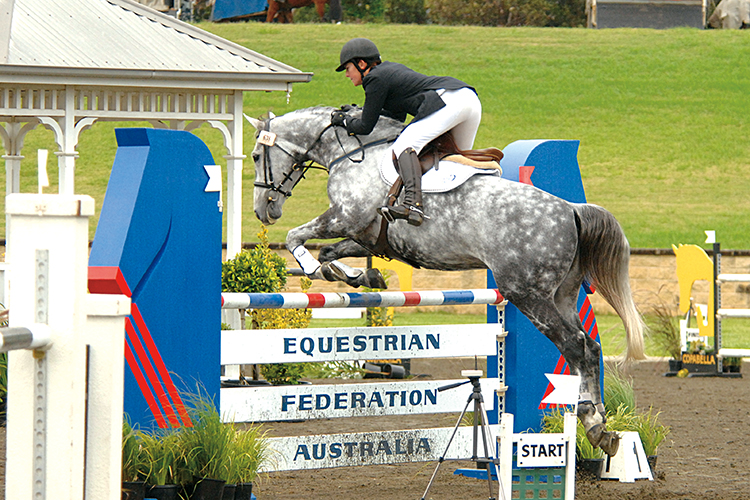 “Triple bar, eight to the plank, he was fantastic to that. In the left hand turn we decided to give him a little more room because it was a positive five to the white fence, and as it was, she ended up with six – again. That’s where the error came. She caught the Liverpool beautiful, she just didn’t trust him to make the distance, she didn’t believe she was going to get down there, so she took hold and added, and it wasn’t there. That is just inexperience.”
“Triple bar, eight to the plank, he was fantastic to that. In the left hand turn we decided to give him a little more room because it was a positive five to the white fence, and as it was, she ended up with six – again. That’s where the error came. She caught the Liverpool beautiful, she just didn’t trust him to make the distance, she didn’t believe she was going to get down there, so she took hold and added, and it wasn’t there. That is just inexperience.”
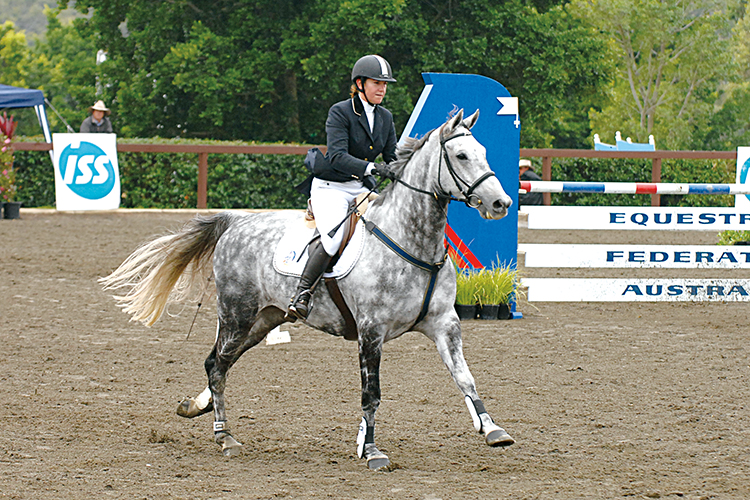
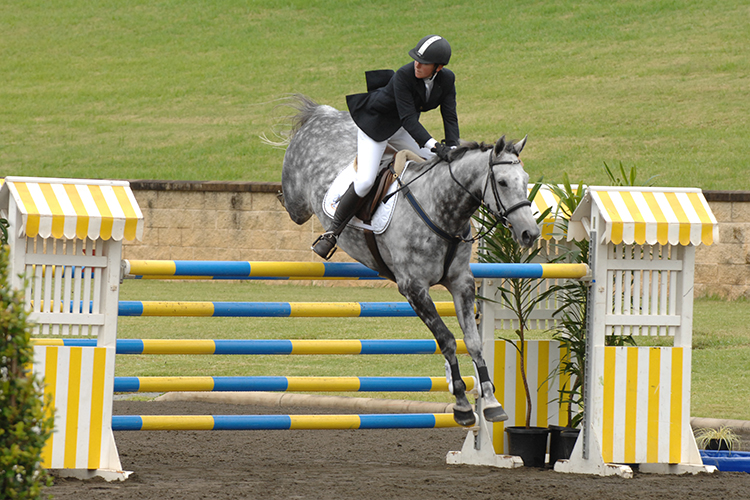
“They came round the corner, tight turn back to the double, he was beautiful in her hand, he jumped the vertical oxer fantastic, then it was a long approach to the next vertical. The plan was to just land, put the leg on, get him in front of her legs, stay tall for the vertical. He did fantastic. Land and gallop, a long distance to the stile, stay cool, jump the stile, quite a tight turn to the oxer. She got her body back, got him in front of her leg, jumped it great, but as she came round to the double, on the left turn, she needed to stay a little wider.”
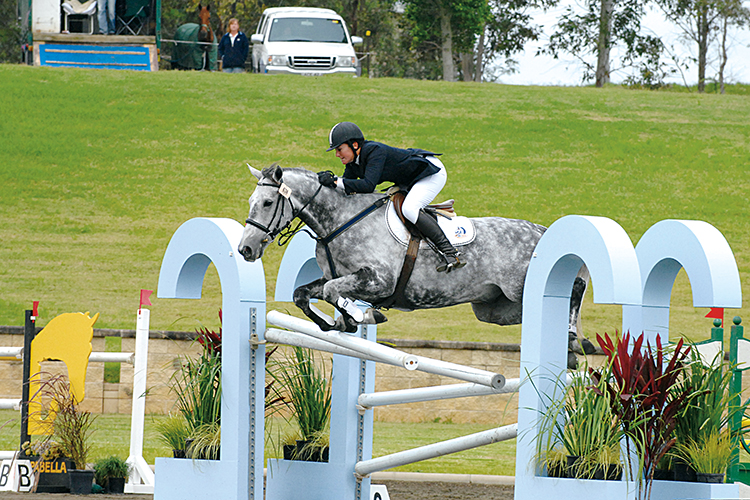
“If you cut your turn to a fence, what happens is that it takes you a little too deep, and she ended up much too deep to the oxer, by surprise. Sometimes when you are learning to ride these classes and you want to go just a little bit faster, you get excited with the speed. She probably just needed to land from that oxer, think, okay I don’t want to cut too tight left, stay a little wider until she was happier with the distance. Instead, she shot him off the turn, wow it’s a big oxer, and just rammed him at it. He ended up getting deep, and on an angle, jumping a little to the right, so he got wide and ended up doing two strides in that. He just jumped up so big over the oxer, and went a little wide. She rode the vertical fantastic, with an inch more experience as a rider, she would have sat up a little more before 13, instead he rubbed it out in front.”
“But if you think about the whole ride, there was lots of fantastic stuff. Amy is really hard on herself for not being perfect. It was just a couple of little rider errors, it’s their first year at this level as a combination, mistakes happen, it’s just part of showjumping. I think there was a lot that was positive to take away.”
Later, when she had stopped being too hard on herself, I caught up with Amy for her impressions of the ride:
“It was probably not as bad as I thought when I first came out, but still there’s a lot of things I need to learn.”
“I knew the Liverpool to the oxer was always going to be a challenge, and I just didn’t think quick enough when I landed. The combination, I just slid across the corner too quickly, got there too deep, and he just kind of went up and down, a little left to right. I didn’t think he’d jump out, but he just chipped in, and did two strides and cleared it. At 13 I got there so sweet, I should have supported him some more. I’m just not used to getting there so well… It was kind of the opposite problem. I just want to go out and do the line again…”
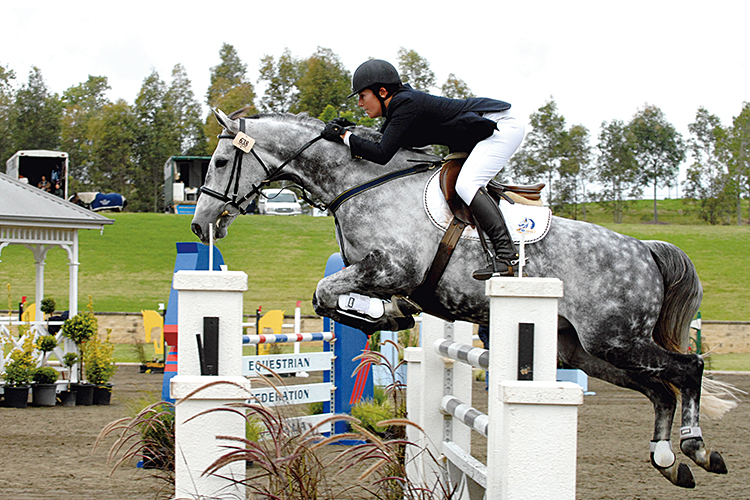 Michelle Strapp on Courses…
Michelle Strapp on Courses…
What are the things you think about when you walk a course for the first time…
It depends on the horse you are riding. Let’s take Charlie for our example. We know how the lines will always ride for him, and one of the important things in your training which makes walking courses, and riding courses, easy, is that you practice your lines. Whether it’s a 23-yard line or a 36-yard line, you understand how they ride for you.
With Charlie, if the distances are going to long distances obviously that is a little more difficult for him. If we walk the first distance and it walks a yard shorter than a true distance, then it is beautiful for Amy, she just knows, it is a lovely six or a lovely five.
One thing we have to watch out for is that sometimes he is not awake at his first fence and if it’s an oxer straight off, he can get a little high and come down on the back rail. So at the beginning, we always like to get him up to 350 / 400 before he comes through the start flags. Amy makes sure she has plenty of activity in her tank, then she comes back to the canter she’d like to jump the first fence with. So the horse is in front of her leg, and in her hand.
Of course it depends on the fence. If it is oxer and longer than a true distance to a triple bar, then there is no consideration that she is going to go down in the true distance. She would have to make sure she lands, adds early, so her last three strides will be moving up to the triple bar. That’s where rideability comes in. There was one line in one of the Australian Championship courses that had a vertical off a turn to a distance that was a yard longer than a true six with a little bend in it. Some went down in the six, it was coming into a vertical combination, a treble, and it wasn’t a long combination so you don’t want to get in there long and flat otherwise you are likely to have the vertical down. Six was never a consideration for us – she put a bend in, so she could be tall for the verticals. So that her body is thinking, wait for the verticals.
Amy got into trouble on a left turn to an oxer. There was quite a wide oxer, and Charlie when he jumps an oxer, needs to be moving up for the last two strides. She came around left turn – it was against the clock and her mind was in a hurry because she wanted to be quick – and she allowed him to cut across the corner, which means that she lost her rhythm and her scope in the canter, which ran her too deep to the oxer. If you come around too quick, it doesn’t allow you to assess what your distance is, to give him room at his oxers. She was around the turn quicker than she thought and he got too deep, and ended up touching the back rail because he had to work too hard at the oxer.
When we walk a course, if we see oxers off tight turns, it’s a matter of Amy staying that bit wider so she doesn’t get the canter too quick and too short through the turn.
Water jumps caused Amy a few problems at the Championships. It is something I was discussing with the course designers, Amy hasn’t jumped a flat water for two years and she has probably jumped one flat water on that horse since she has owned it. It’s a bit sad that we are not striking water jumps for riders to get experience on.
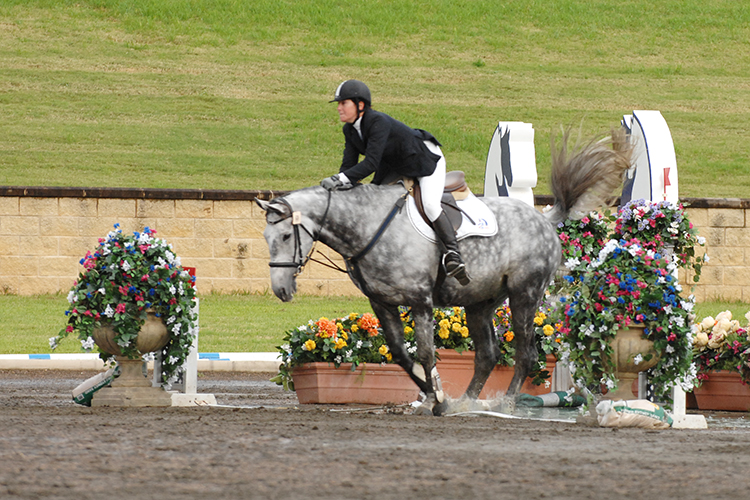
I’m probably going to put in a flat water at my place, so at least she’s got something to train over. The water jump got her into trouble in every class, even when it had the rail over the top. She rode the water quite well, but because Charlie was trying to keep off it a little, she would see a distance to the base of the water but because he was looking, the distance never took her to the base. There was a vertical before it, so I said, land, put him in front of your leg, give him a little tickle with your spur, get him up to 350 to 400 as soon as you land, so it gives her a canter that she can assess a distance in. If she lands and gets too short after the vertical, then she is working from a canter that is already too short.
In the first round, she came off the left rein – and remember we have been working on Charlie’s tendency to have a right bulge which we hadn’t seen for a while, but we did this day. He came off the turn, jumped it a bit spooky, drifted to the right and landed short after the water and to the right. John Vallance, the course designer, had made the distance to the next fence for most horses a five that would come up. Sometimes if your horse draws after water – lands and keeps travelling – then the distances ride short. But not for Charlie, because when Charlie jumps water he gets hung up in the air and lands short and dead.

When we walked the course, and stood away from the oxer, I said this is going to be long for Charlie, but the six was not there. The six was backwards and would be teaching Amy to land and grab, which we don’t want to do. You really need to ride the five. If she were overseas she would have to ride the five. So he landed, jumped to the right, so it was five and a quarter, and she ended up doing the six. You walk a line like that and you think, it probably suits the horse to land and grab and do the six but it certainly doesn’t suit the jockey. And he CAN do the five but she has to strike the water well, there’s no room for error at the water, and he has to stay straight.
In the Grand Prix she got four faults in the water, which cost her, because all the four faulters jumped off, and she also had four faults from the combination. I suggested she ride water like a big triple bar, because with a big triple bar you want to be coming forward to the base. But even though she felt like she was coming to the base, she was a good meter away from it. He tried hard, he put his feet out the front, but landed on the tape. So especially with Charlie, rather than discussing how she needs ride water jumps, what she really needs is practice.
The yellow wall caused drama on the final day?
The biggest problem was a horse getting in there and being surprised by the wall – and getting a little backed off. The clever riders gave their horse a good look at the wall before they the bell rang. If there is a fence you are worried about, let them go in and look at it before you start.
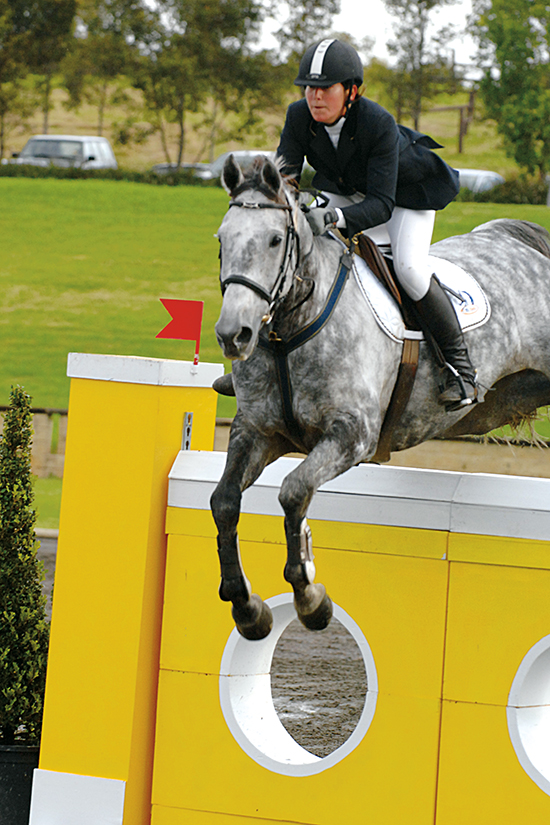
Chris Chugg says that he thinks it is the colour, yellow?
“In my whole career, I have never looked at a fence and worried about the colour, that’s just my opinion. I think for me it is a psychological thing, I’ve tried never to let it worry me because there is nothing you can do about it – and I try not to let Amy think about colour. The only colour that I find I have to be careful about, is colour that blends into the base of an arena. The judgement of the top rail is never as good in that situation.
But definitely yellow will make a horse come off a fence – it’s bright and it is a little bit hard for them to concentrate on the top rail because they look at the whole obstacle, and it is startling because it is bright. We walk a course and if the jump is yellow, or green or red, it is never something that I bring into discussion, other than they are going to look at this wall – and they all did. They land from an oxer and suddenly they’ve got an obstacle as bright as that in front of them – they are going to be a little backed off. If it was bright green they would be backed off too.
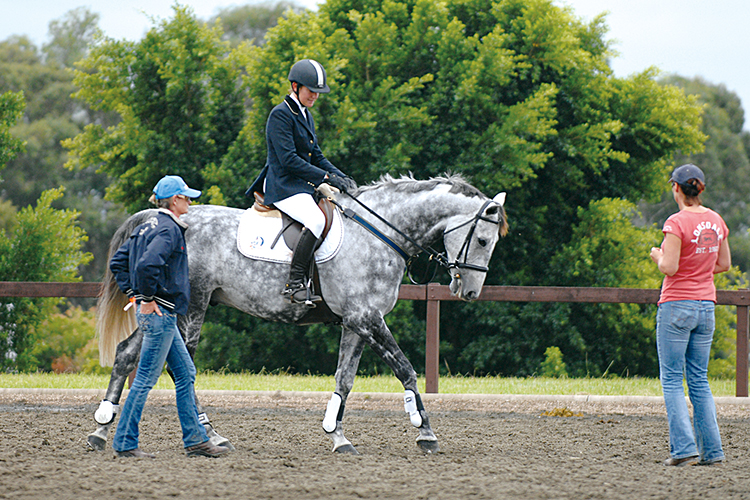
How much is it a matter of reading the going of the arena?
Very much so, and again it depends on your horse. The going at SIEC, even though it was wet, it wasn’t slippery. If we were in grass and it was heavy going, it would be very hard for a horse like Charlie, because he doesn’t have the gas in his tank to pull out of mud. Other horses are super in the mud. Most horses that are really good in heavy mud are not careful horses; mud makes them try harder because they have to second-guess. It’s a bit like being ridden by someone who is not sure where the takeoff is. I’ve always found a careless horse is better in the heavy mud, where a careless horse on a beautiful surface is not so careful, it’s too easy for them. With Charlie, the better the surface, the better he goes. Careful horses always tell you if it is not a good surface because they get worried. They don’t like shifty ground because they are so good at reading the top rails, and if they read a top rail and suddenly fall into a bit of mud and the top rail shifts that worries them, because they are so watchful of that top rail. A careless horse sinks into the mud, the top rail shifts and they think they better do a little more. The surface is very important.
The practice area at Sydney starting sliding a little, and your preparation area is very important too. Again, it depends on the rider, but at Amy’s stage, it is really important that she gets a good warmup. I think she has quite a good head on her, she can have a mistake in the practice arena and pull through, whereas some don’t. Often you think about different things on the course – in the Championship course, the second fence was quite a big oxer after a vertical in. If that had been vertical / vertical I wouldn’t have got her riding the first jump quite as positive – but we can with Charlie because he is so careful. So I said, ride your first fence, the vertical, as if it is an oxer because the second fence is the oxer near the in-gate and it is quite big. If she’d got too sticky at the first vertical with Charlie, she wouldn’t have had the rhythm up and running for the oxer. She is very good at riding to plans, I said jump the first vertical at 350 and trust his carefulness, and you will be in the rhythm to jump that decent oxer.
With Charlie we don’t do too many cross rails in the warm up, we might do one cross rail just to let him canter over. He’s very good at the verticals, she just has to make sure he is very straight, so we work on the straightness to the verticals. The biggest thing for Amy is riding oxers in the practice arena, because he is not motivated. She then gets caught trying to hassle his canter through the turn instead of trying to concentrate on the rhythm, and then he runs – and if he runs, he runs to the base of the oxer and then he just goes up and down, and can’t use any scope.
We concentrate on not spending ages warming him up, but use transitions, making him gallop forward – walk – gallop forward – walk, so she gets the feeling of him being in front of her leg. He warmed up fantastically for the Australian Championship, probably one of the best warmups I’ve ever seen Amy do. I could get her to just pick up the canter, put him in front of her leg, and he actually held a rhythm through the turn which gave her time to feel that she could ride up to her oxers in the practice arena – to just give him that room and then he is super, he has such a good technique. Getting him in front of her leg in the practice arena is one of the hardest things.
What did you come away from the Australian Champs thinking about?
I think Amy gained a lot at the Australian Championships, she got the feeling that she could really get him in front of your leg. It’s a gradual thing. You think you have your horse in front of your leg but then suddenly you realize that you don’t – I think it is starting to become more concrete for her. Now she can really feel when he is in front of her leg. The other lesson we learnt, is that she has got to learn how to ride water.
That’s the biggest thing, because she rode very very well. She had success going quick and winning a few classes. She was so keen to win, she has such a winning spirit, that she was thinking ‘I’ve got to get around this corner as fast as I can’, but then forgetting about her balance, and that resulted in a few mistakes. It’s her maturity against the clock, to keep her brain thinking, ‘I want to win the class’ but actually have a feeling of where her horse’s balance is at the same time.
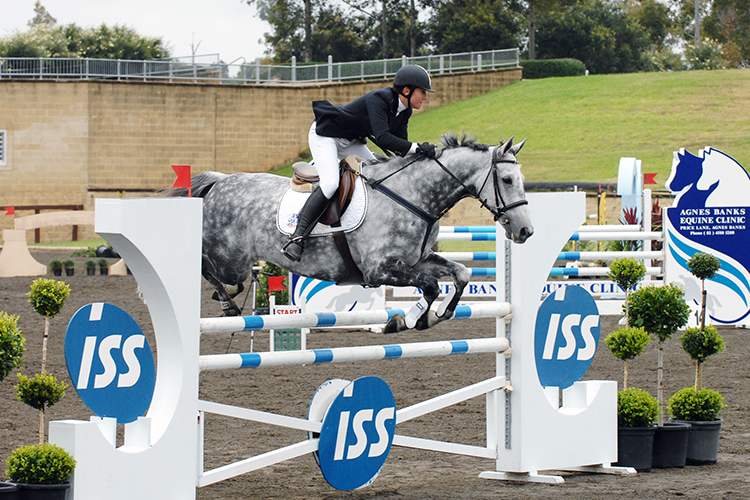
“Here Amy is using her eye really well. This was against the clock in the Mini Prix, the class she won. You have to be careful, if you teach a rider to use their eyes too early – they tend to twist their whole body instead of as you can see in this photo, following her horse’s mouth. She’s got a great lower leg, and her body is straight, her chest is still in the centre of the horse’s crest. A lot of riders have been taught to look, and they look early but they twist their whole body, and make the horse crooked through the air. Amy is really on the job there, she wants to win…”
“The water got Amy into trouble all weekend because she doesn’t have enough experience riding it. You can see in this photo that she was a long long way off the water – she landed in the water but didn’t get faults because there was a pole over the water, and she didn’t have that down – but John Vallance made a related distance straight after the water, and because Charlie was so long at the water, he landed so short that the related distance didn’t ride well for Amy. You can see in the photo, he’s really trying to jump it, he’s just too long.”


